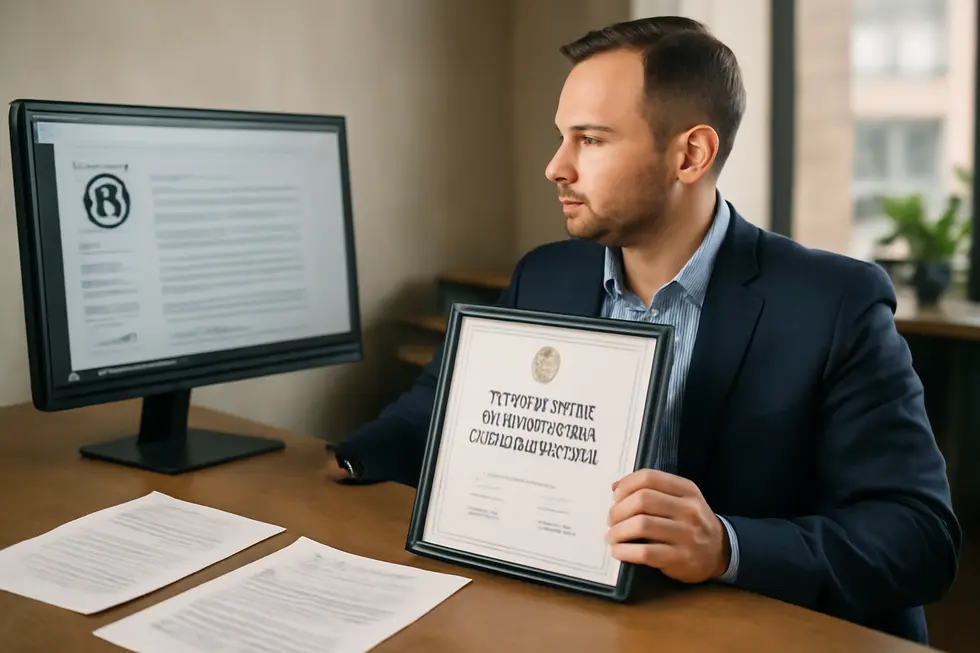Introduction
Securing a trademark for your business name is an essential step toward establishing a protected brand identity. A trademark grants exclusive rights, shields your reputation, and enhances your credibility in the marketplace. Understanding how to get a name trademarked empowers business owners to navigate legal complexities and avoid costly pitfalls. This guide breaks down the trademark registration process into five focused chapters: conducting a comprehensive search to ensure your name’s availability, accurately filing your trademark application, managing the examination and opposition phases, fulfilling post-registration responsibilities, and leveraging professional assistance alongside strategic preparation. Each chapter builds upon the last to provide a clear, actionable roadmap that helps you transform your chosen name into a legally protected asset.
Tables of Contents
Chapter 1: Conducting a Comprehensive Search for How to Get a Name Trademarked
- Harnessing USPTO’s TESS: The Essential First Step in Name Trademark Searches
- Navigating the USPTO Application: Essential Steps to Prepare, File, and Track Your Trademark Submission
- Navigating Legal Complexities and Leveraging Expert Guidance in Trademark Searches
- Navigating Trademark Application Progress: Key Steps to Monitor Status and Address Office Actions Effectively
- Sustaining and Defending Your Trademark: Long-Term Enforcement and Maintenance Strategies
Chapter 2: Filing Your Application in the Process of How to Get a Name Trademarked
- Mastering the Crucial Pre-Filing Step: Conducting an Exhaustive Trademark Search
- Gathering Essential Documentation and Details to Perfect Your Trademark Application
- Step-by-Step Guide to Accurately Completing and Submitting the USPTO Trademark Application Online
- Navigating the Trademark Examination: How to Respond Effectively to Office Actions
- Sustaining Your Trademark: Essential Use, Renewals, and Protection After Filing
Chapter 3: Navigating the Examination and Opposition Phase of How to Get a Name Trademarked
- Mastering the Trademark Examination Phase: Key Steps to Secure Your Name
- Strategic Responses to Office Actions and Oppositions in Trademark Registration
- Understanding the Trademark Opposition Process: Protecting Your Name Before Registration
- Mastering Opposition Tactics: Strategic Steps to Defend or Challenge a Trademark Name
- Mastering Critical Deadlines and Legal Guidance During Trademark Examination and Opposition
Chapter 4: Post-Registration Responsibilities and Enforcement: Safeguarding Your Registered Trademark
- Ongoing Vigilance: Monitoring and Defending Your Trademark After Registration
- Essential Trademark Maintenance and Renewal Duties for Sustaining Protection
- Mastering Legal Enforcement and Litigation Tactics to Safeguard Your Registered Name Trademark
- Sustaining Brand Value: The Economic and Societal Imperatives of Trademark Maintenance and Enforcement
- Navigating Technological Tools and Geopolitical Challenges in Trademark Enforcement
Chapter 5: Utilizing Professional Help and Strategic Preparation for How to Get a Name Trademarked
- Maximizing Trademark Success: How Professional Guidance and Strategic Planning Secure Your Name
- Mastering Strategic Preparation and Leveraging Expert Assistance to Secure Your Name Trademark
- Mastering the Legal Path: Effective Strategies and Expert Guidance for Trademarking a Name
- Essential Post-Filing Monitoring and Enforcement Strategies for Trademark Success
- Balancing Costs and Timelines: Essential Factors in Strategic Trademark Preparation
Chapter 1: Conducting a Comprehensive Search for How to Get a Name Trademarked

1. Harnessing USPTO’s TESS: The Essential First Step in Name Trademark Searches
Before filing a trademark application, it is critical to verify the availability of your desired name. The USPTO’s Trademark Electronic Search System (TESS) is the primary resource for this, enabling thorough searches for identical or similar trademarks within relevant classes. Begin by accessing TESS through the USPTO website and select the “Word and/or Design Mark Search (Free Form)” option for flexible and precise queries. Input your proposed name and carefully analyze results to detect potential conflicts. Identifying identical or confusingly similar trademarks early helps avoid costly legal challenges and application refusals. If conflicts arise, reconsider your name or seek professional counsel to navigate complexities. Following this, gather detailed trademark information before submitting your application. Effective use of TESS streamlines the registration process, reducing risks of rejection and reinforcing your pathway to exclusive name rights. For deeper insights, explore resources on trademark protection for business names and logos.
2. Navigating the USPTO Application: Essential Steps to Prepare, File, and Track Your Trademark Submission
Filing a trademark application with the USPTO demands careful preparation and precise execution. Begin by collecting critical details about your desired name, including its exact spelling, the goods or services it will represent, and whether you seek registration of just the text or a logo. You must submit a specimen demonstrating actual commercial use or a bona fide intent to use the name. The application is completed online through the USPTO’s Trademark Electronic Application System (TEAS), which requires identity verification via ID.me. Be prepared to pay filing fees, typically between $250 and $350 per class of goods or services. After submission, it’s crucial to monitor your application’s status regularly on the USPTO site to address any office actions or information requests promptly. This diligent process ensures your trademark registration proceeds smoothly and the name gains strong federal protection. For more on protecting your business identity, explore insights on trademark preservation and enforcement.
3. Navigating Legal Complexities and Leveraging Expert Guidance in Trademark Searches
Before filing a trademark application, it is crucial to undertake an exhaustive search to assess the availability of your desired name. This process goes beyond a basic check using the USPTO’s Trademark Electronic Search System (TESS); it also includes exploring state trademarks, common law rights, and domain name registrations to uncover potential conflicts. Such thorough investigation reduces the risk of infringement disputes and application refusals. Given trademark law’s complexity, consulting an intellectual property attorney can prove invaluable. Legal experts expertly interpret search outcomes, advise on potential risks, and guide you through nuanced legal requirements. Their involvement enhances strategic decision-making, helps tailor your application, and improves your ability to respond effectively to possible objections or oppositions. Embarking on this cautious, well-informed journey sets a strong foundation for securing exclusive rights to your name and fortifying your brand identity. For further insight on legal protections, see trademark protection for business names and logos.
4. Navigating Trademark Application Progress: Key Steps to Monitor Status and Address Office Actions Effectively
Successfully securing a trademarked name extends beyond conducting a thorough search and filing your application; it requires vigilant monitoring and prompt responses to any office communications. After submitting your application, regularly checking its status through the trademark office’s portal is essential to track examination progress and identify any office actions. These communications often flag issues such as conflicting marks, descriptiveness, or incomplete information, demanding timely and precise replies typically within 30 to 90 days. Ignoring these deadlines can result in abandonment of your application. Responding effectively may involve clarifying the application, amending filings, or providing additional evidence to overcome refusals. Engaging a trademark attorney during this stage can significantly improve your chances of overcoming legal hurdles. Staying proactive during this phase ensures your path toward registration remains unimpeded and lays the foundation for long-term protection of your brand name. For a deeper understanding, reviewing comprehensive trademark resources can provide valuable insights on this crucial stage.
5. Sustaining and Defending Your Trademark: Long-Term Enforcement and Maintenance Strategies
Securing a trademark for your name is only the beginning; maintaining and defending it requires ongoing vigilance. After registration, you must actively enforce your rights by monitoring for infringements and promptly sending cease-and-desist letters when unauthorized use appears. If necessary, be prepared to pursue legal action to uphold the exclusivity granted by your trademark. Equally important is the timely upkeep of your registration through filings such as the Declaration of Continued Use between the 5th and 6th year and renewals every 10 years, supported by accurate documentation proving active use in commerce. Protecting your trademark also involves monitoring marketplaces and databases, controlling licensing agreements to maintain brand integrity, and potentially using customs recordation to prevent counterfeit imports. These efforts collectively preserve the value of your trademark, ensuring long-term exclusivity and legal protection. For more about trademark rights and enforcement, see trademark protection for business name and logo.
Chapter 2: Filing Your Application in the Process of How to Get a Name Trademarked

1. Mastering the Crucial Pre-Filing Step: Conducting an Exhaustive Trademark Search
Before filing your trademark application, conducting an exhaustive search is essential to ensure your desired name is unique and free from conflicts. The search begins with accessing the USPTO’s Trademark Electronic Search System (TESS), where you check for exact matches and similar trademarks. It’s important to consider all variations—different spellings, singular and plural forms, and phonetic equivalents—since trademarks are matched primarily on exact terms. Extending your search beyond federal records to state databases and common law trademarks helps uncover unregistered but active marks that might block registration. If your mark includes a logo, you should investigate relevant design codes using the USPTO’s Design Search Manual. Modern AI-powered search tools can further enhance thoroughness by detecting visual and conceptual similarities. Careful analysis of your findings helps anticipate potential objections. In complex cases, consulting a trademark professional for a clearance report can save time and reduce risks, setting a strong foundation for a successful application. For additional guidance, see trademark protection for business names and logos.
2. Gathering Essential Documentation and Details to Perfect Your Trademark Application
Before filing your trademark application, assembling comprehensive and accurate documentation is crucial for a smooth process. Begin with clear applicant information, including your full legal name or business name, along with complete contact details. Precisely present the trademark—whether as plain text or a logo—ensuring the depiction matches the intended protection scope. Define the goods or services associated with the trademark using exact classification language to clarify its commercial use. Additional documents may be necessary, such as incorporation certificates, partnership deeds, or identity proofs of authorized signatories depending on your business structure. A meticulously completed application form, free of errors, avoids delays and objections. Be prepared to pay the appropriate filing fees, which vary by jurisdiction and classification count. Preparing these elements carefully streamlines your trademark submission, increasing chances of successful registration. For guidance on trademark protection, consulting resources like trademark protection for business names and logos can provide valuable insights.
3. Step-by-Step Guide to Accurately Completing and Submitting the USPTO Trademark Application Online
Filing your trademark application with the USPTO begins by creating an account on USPTO.gov and verifying your identity via ID.me, a required security step. Once logged in, you choose the option to register a trademark and carefully input all necessary information, including your personal details, the specific trademark name or logo, and the associated goods or services classification. It is crucial to accurately state whether the filing is based on actual use in commerce or intent-to-use, reflecting your mark’s current status. After completing the form, pay the electronic filing fee to submit your application. Submission triggers assignment of a unique serial number, allowing you to track progress online. Electronic filing streamlines the process, reduces costs, and enables efficient communication with the USPTO throughout the application’s life cycle. For comprehensive trademark protection guidance, consider resources on trademark protections for business names and logos.
4. Navigating the Trademark Examination: How to Respond Effectively to Office Actions
Once you file your trademark application, it enters a meticulous review stage where a trademark examiner conducts both a technical and legal evaluation. The examiner confirms your application is complete and checks for any conflicts with existing trademarks or legal issues such as descriptiveness. If concerns arise, you will receive an office action—a formal notice detailing the objections. You must respond carefully within a limited timeframe, addressing all points raised to avoid abandonment. Failure to meet deadlines or respond adequately can halt your trademark registration. Understanding this review and mastering your response to office actions greatly improves your chances of securing the trademark. For deeper insight into managing office actions and the examination process, exploring specialized trademark resources can be invaluable.
5. Sustaining Your Trademark: Essential Use, Renewals, and Protection After Filing
Successfully filing a trademark application marks just the beginning of protecting your name. To sustain your trademark, continuous use in commerce is critical alongside timely maintenance filings with the USPTO. Key obligations include submitting a Declaration of Continued Use between the 5th and 6th year to prove the mark remains active, failure of which risks cancellation. After five years, a Declaration of Incontestability can solidify your mark by limiting legal disputes. Trademark renewal occurs every 10 years through a combined Declaration of Use and Renewal Application, enabling you to preserve exclusive rights for another decade. Maintaining evidence like product labels or advertisements supports these filings. Constant vigilance against infringement and careful monitoring of deadlines, while avoiding deceptive third-party solicitations, ensures your trademark endures as a valuable asset. Consulting specialized counsel can ease this ongoing process and safeguard your brand effectively.
Chapter 3: Navigating the Examination and Opposition Phase of How to Get a Name Trademarked

1. Mastering the Trademark Examination Phase: Key Steps to Secure Your Name
The examination phase is a pivotal step in trademark registration where the trademark office meticulously reviews your application. Examiners assess its completeness, verify fee payments, and examine the name’s distinctiveness and potential conflicts with existing trademarks. This process ensures your proposed name meets all legal criteria and does not infringe on prior marks. If concerns arise, an official examination report outlines objections and allows you to respond or amend the filing. Timely and precise replies are crucial to prevent abandonment. Successfully navigating this stage secures your application’s progress to publication, where third-party opposition may follow. Preparatory thorough searches and strategic responses during examination greatly increase your chance of approval. For additional insights, exploring resources on trademark protection for business names can provide useful guidance.
2. Strategic Responses to Office Actions and Oppositions in Trademark Registration
Successfully navigating the examination and opposition phases requires careful, strategic responses to challenges from the trademark office and third parties. When an Office Action is issued, it’s crucial to address every objection comprehensively and professionally, supporting arguments with legal precedents and factual evidence. Prompt, thorough replies increase the likelihood of overcoming refusals related to confusion or descriptiveness. In cases of opposition, defending the trademark involves formal hearings and presenting clear market research and consumer perception evidence to counter claims. Engaging constructively with examiners or opposition boards through interviews or written responses can clarify issues and strengthen your position. Partnering with a trademark attorney throughout these stages often proves invaluable, ensuring legal nuances are expertly managed to protect your rights effectively. For insights on trademark rights and protection strategies, consider exploring detailed resources about trademark protection for business names and logos.
3. Understanding the Trademark Opposition Process: Protecting Your Name Before Registration
Once your trademark application is published, it enters the opposition phase—a critical period where third parties may formally contest your trademark to protect their existing rights. This phase begins with the publication of your application in the official trademark gazette, opening a limited window for oppositions. Opponents must submit a detailed notice outlining why your trademark should not register, often citing likely confusion, descriptiveness, or prior rights. Both parties then present evidence and legal arguments, and the trademark office may hold hearings to resolve disputes. Successfully navigating this process requires careful monitoring, prompt responses, and strong evidence to defend your trademark name. Understanding the opposition phase is vital to secure exclusive rights and prevent costly delays or refusal. For further insights on maintaining and enforcing trademark rights, businesses may find valuable guidance on trademark protection and legal strategies.
4. Mastering Opposition Tactics: Strategic Steps to Defend or Challenge a Trademark Name
Successfully navigating the opposition phase in trademark registration requires a focused, evidence-driven strategy. Opponents must file timely, specific notices detailing precise grounds for opposition, supported by tangible proof such as documented marketplace confusion or brand recognition. Equally important is procedural precision—missing deadlines or forms can forfeit rights. Applicants facing opposition should craft comprehensive counter-statements addressing each claim with legal precedents and factual rebuttals, backed by clear evidence of distinctiveness. Both parties need to prepare for hearings by organizing disclosures, anticipating arguments, and adhering to procedural rules. Engaging trademark legal experts enhances the ability to present persuasive arguments and manage complex proceedings effectively. Understanding these tactics helps ensure protection or challenge of trademark names during this critical phase. For more on trademark rights and opposition, see detailed guidance on common law trademark rights.
5. Mastering Critical Deadlines and Legal Guidance During Trademark Examination and Opposition
Successfully navigating the examination and opposition phases hinges on strict adherence to critical deadlines and expert legal guidance. Applicants typically have 30 days to respond to examination objections—called office actions—with detailed, legally supported replies to avoid abandonment. After publication, potential challengers can file oppositions within 4 months based on reasons like confusion or descriptiveness. The applicant then has 2 months to submit a counter-statement or risk losing the application. This process involves presenting evidence and possibly attending hearings, where professional legal counsel proves invaluable. Expert attorneys help monitor deadlines, interpret legal issues, craft persuasive arguments, and manage disputes effectively. Missing deadlines or inadequate responses can forfeit trademark rights and undermine brand protection. Ensuring timely, strategic action during these phases greatly increases the chance of securing exclusive rights to a name. For more on protecting your brand, explore trademark protections for business names and logos.
Chapter 4: Post-Registration Responsibilities and Enforcement: Safeguarding Your Registered Trademark

1. Ongoing Vigilance: Monitoring and Defending Your Trademark After Registration
Ongoing Vigilance: Monitoring and Defending Your Trademark After Registration
After successfully registering a name trademark, the crucial work of protecting it begins. Trademark owners must vigilantly monitor for unauthorized or confusingly similar uses that could weaken their mark’s distinctiveness. Regularly reviewing trademark office databases, setting up online alerts, or employing specialized monitoring services can detect potential infringements early. Upon identifying unauthorized use, owners typically initiate enforcement by sending cease-and-desist letters and seeking settlement where possible to avoid costly litigation. If necessary, legal action can be pursued to stop infringement and seek damages. Maintaining registration also requires attention to deadlines, such as filing declarations of use around the fifth year and renewing every ten years to avoid cancellation. Advances in AI-driven monitoring tools now offer real-time tracking and compliance oversight, strengthening enforcement efforts and preserving exclusive rights. This active post-registration management is essential to secure the trademark’s long-term value and legal protection.
For more on protecting your trademark rights after registration, see trademark protection business name logo.
2. Essential Trademark Maintenance and Renewal Duties for Sustaining Protection
Maintaining and renewing a trademark are crucial to preserving its exclusive rights. In the U.S., owners must file a Declaration of Use between the 5th and 6th year to confirm ongoing commerce use. Every ten years, a combined Declaration of Use and Renewal Application is due to extend the registration. Filing a Declaration of Incontestability after five consecutive years of use further strengthens legal protection. Failing these deadlines risks cancellation and loss of trademark rights. Meanwhile, in the European Union, trademarks renew every 10 years without mandatory proof of use, but continuous inactivity for five years invites cancellation for non-use. Beyond filings, owners must vigilantly monitor infringement, enforce rights actively, and respond to possible conflicts. This ongoing commitment ensures the trademark remains a valuable and enforceable asset. For detailed guidance, resources on trademark protection for business names offer practical insights.
3. Mastering Legal Enforcement and Litigation Tactics to Safeguard Your Registered Name Trademark
Maintaining a registered trademark requires proactive enforcement to preserve its exclusivity and prevent dilution or infringement. Once your name is trademarked, continuous monitoring of its use is crucial to swiftly identify unauthorized exploitation, whether in traditional markets or digital platforms. Collecting and presenting evidence of use safeguards against cancellation for non-use, while legal responses to infringement include cease-and-desist letters and, when necessary, litigation. Strategic negotiation can often resolve disputes without costly court battles. Licensing agreements must incorporate quality control measures to uphold trademark strength and legal standing. Additionally, staying alert to opposition filings during publication and timely addressing office actions strengthens your trademark’s defenses. Employing professional counsel and trademark watch services enhances your ability to navigate complex enforcement landscapes and preserve your brand’s legal rights effectively. For more in-depth insights on trademark protection and management, see detailed guidance on trademark protection of business names and logos.
4. Sustaining Brand Value: The Economic and Societal Imperatives of Trademark Maintenance and Enforcement
Successfully trademarking a name marks only the beginning of ongoing responsibilities essential to preserving its value and legal protection. After registration, owners must vigilantly monitor unauthorized use to prevent brand dilution and consumer confusion. This vigilance includes conducting regular searches and enforcing rights through cease-and-desist notices or litigation if needed. Economically, fulfilling these duties preserves the investment poured into building brand equity and prevents costly disputes or rebranding. It also smooths market expansion by ensuring consistent trademark protection across jurisdictions, mitigating risks like trademark squatting. Societally, active enforcement guarantees clear product origin identification and fosters fair competition. Yet, these benefits require allocating resources to legal and administrative tasks, a burden heightened by recent fee increases. Developing internal systems and retaining specialized counsel helps navigate these demands effectively, securing the trademark’s enduring strength and reputation. For further guidance, exploring trademark protection strategies can deepen understanding of these crucial post-registration steps.
5. Navigating Technological Tools and Geopolitical Challenges in Trademark Enforcement
After successfully registering a name trademark, maintaining its protection requires vigilance against unauthorized use, especially in digital environments. The internet demands constant monitoring of domain names, e-commerce platforms, and social media to detect infringement quickly. Utilizing advanced digital tools streamlines this surveillance and supports enforcement actions, including litigation or alternative dispute resolution. Simultaneously, enforcing a trademark internationally involves navigating complex geopolitical landscapes, as intellectual property laws differ widely by country. Trademark owners must strategically file in key markets and adapt to regional regulations, such as electronic commerce mandates that expedite removal of infringing content. Licensing agreements should also reflect geopolitical risks like currency fluctuations and local compliance. Balancing these technological and geopolitical factors is essential to uphold trademark rights effectively, ensuring your brand remains strong, valid, and defensible. For a deeper understanding of trademark protections for business names and logos, resources like trademark protection for business name and logo offer valuable guidance.
Chapter 5: Utilizing Professional Help and Strategic Preparation for How to Get a Name Trademarked

1. Maximizing Trademark Success: How Professional Guidance and Strategic Planning Secure Your Name
Successfully trademarking a name demands precision and foresight, where professional expertise and strategic preparation are indispensable. Trademark attorneys and specialist services expertly navigate complex legal requirements, conducting exhaustive searches to confirm a name’s uniqueness and preparing detailed applications that meet stringent standards. This professional oversight prevents common errors that often cause delays or refusals. Strategic planning also plays a vital role; filing early—with thorough market testing and securing related digital assets—helps prevent conflicts and safeguards brand identity from competitors. Throughout the lengthy application timeline, expert counsel ensures timely responses to legal inquiries and defends the trademark’s validity after registration. By combining legal skill with proactive preparation, applicants can confidently protect their brand’s name, ensuring robust, long-term intellectual property protection. For more insights, see this resource on trademark protection for business name and logo.
2. Mastering Strategic Preparation and Leveraging Expert Assistance to Secure Your Name Trademark
Successful trademark registration begins with deliberate strategic preparation and expert guidance. Starting with a thorough search using resources like the USPTO’s TESS system ensures your chosen name is available and reduces risks of rejection. Engaging a knowledgeable trademark attorney or specialist provides invaluable support in accurately defining your trademark scope, selecting the appropriate classes, and completing detailed documentation. Early application filing, ideally before public use, safeguards priority rights, while clear decisions on the trademark type and filing basis—actual use or intent to use—clarify the legal approach. Throughout the lengthy review process, professionals assist in monitoring status, managing official communications, and addressing potential office actions promptly. Careful budgeting for fees and timelines complemented by pre-filing brand testing and securing online assets solidify your trademark’s foundation. Combining these strategic steps with professional counsel streamlines the path to strong legal protection, as detailed in trademark protection guidance resources.
3. Mastering the Legal Path: Effective Strategies and Expert Guidance for Trademarking a Name
Successfully trademarking a name requires mastering the legal framework through strategic planning and professional assistance. Beginning with a thorough trademark search is crucial; professionals offer in-depth clearance searches covering federal, state, and common law trademarks to avoid conflicts. Understanding the trademark system—whether first-to-file or first-to-use—guides whether to pursue state or federal registration, each with distinct geographic and legal benefits. Preparing and filing an accurate application demands attention to detail, from classifying goods or services properly to responding promptly to office actions. Budgeting for fees and processing time helps manage expectations. Post-registration, ongoing monitoring and enforcement are vital to protect exclusive rights. Leveraging expert legal counsel streamlines this complex process, reduces errors, and fortifies your brand’s legal foundation. For more insight on trademark protection, see trademark protection for business names and logos.
4. Essential Post-Filing Monitoring and Enforcement Strategies for Trademark Success
Successfully trademarking a name extends well beyond filing the application; vigilant post-filing monitoring is crucial. This process involves actively tracking new trademark registrations, domain names, and marketplace activity to detect potential infringements early. Professional trademark attorneys or specialized monitoring services can enhance this vigilance by scanning multiple sources, including USPTO records and online platforms, ensuring no conflicting use escapes notice. When conflicts arise, enforcement actions such as cease-and-desist letters or oppositions must be pursued decisively to maintain exclusive rights. Strategic preparation prior to filing also informs timely enforcement decisions by balancing legal tactics with brand goals. Consistent monitoring and enforcement safeguard your trademark from dilution or loss. For a deeper understanding of trademark protection, explore expert insights on trademark protection for business names and logos.
5. Balancing Costs and Timelines: Essential Factors in Strategic Trademark Preparation
Securing a trademark involves navigating both cost and time with strategic foresight. State registrations, such as those in Texas, provide an affordable option around $50 per class, with faster processing but limited geographic protection. Federal filings through the USPTO cost between $250 and $350 per class, plus additional expenses for professional trademark searches and attorney involvement, which can bring total costs from a few hundred to over $5,000 depending on complexity. Time frames vary widely; comprehensive searches take days to weeks, while federal examination spans several months up to over a year, especially if office actions arise. Employing experienced legal help often expedites the process and reduces risks but adds to fees ranging typically from $1,000 to $2,000 for straightforward filings. Careful planning also considers ongoing costs for renewals and enforcement. This balance between expense, timing, and professional guidance ensures an effective trademark strategy that minimizes delays and costly mistakes. For deeper insight into state-level options, see the detailed discussion on state trademark registration.
Final thoughts
Successfully securing a trademark for your business name is a vital investment into your brand’s future and market identity. By thoroughly conducting a comprehensive name search, carefully preparing and filing your application, adeptly navigating the examination and opposition phases, and conscientiously managing post-registration responsibilities, you lay a strong foundation for exclusive legal protection. Leveraging professional expertise and planning strategically further enhances your chances of success while safeguarding your intellectual property from infringement. Understanding and following these essential steps equips business owners to confidently protect their names and build lasting brand value in an increasingly competitive environment.
Your IP is the foundation of your success – let’s protect it together before it’s too late. We can’t wait to help you turn your ideas into legally secured assets.
About us
undefined



Thanks for sharing. I read many of your blog posts, cool, your blog is very good.